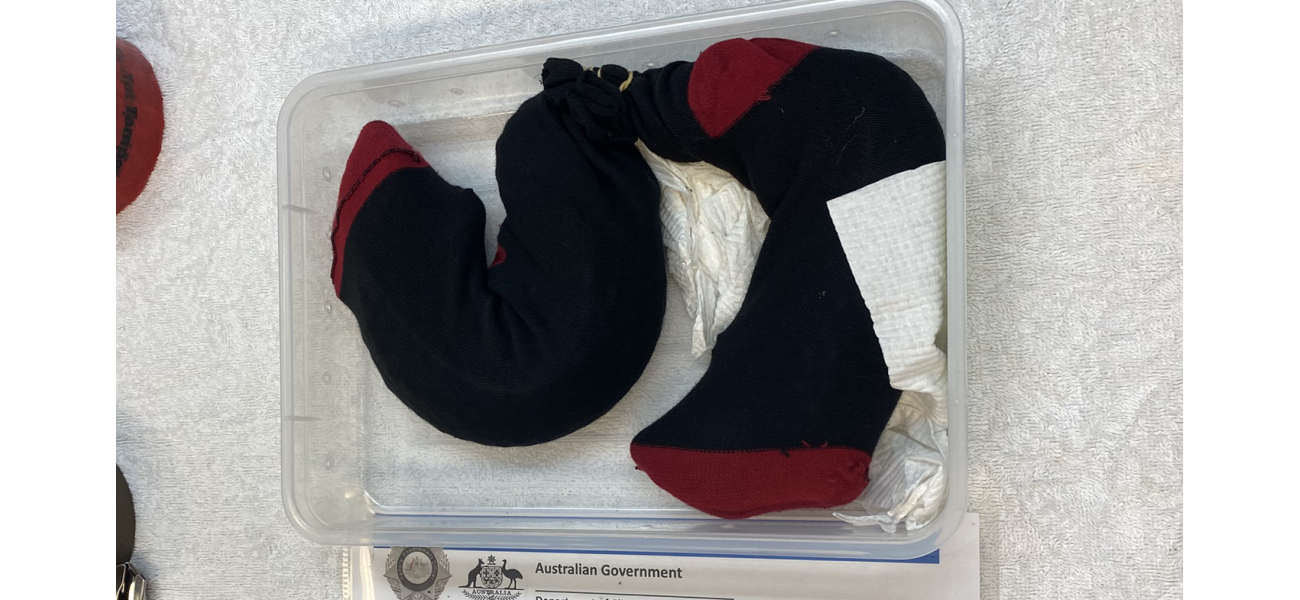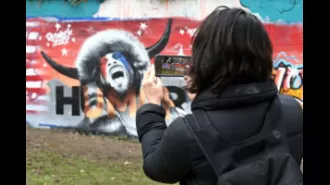Socks with valuable hidden creatures worth $25k.
Thousands of valuable Australian reptiles being illegally transported in socks and chocolate boxes.
September 15th 2024.

As you approach the shallow plastic storage tub, you can see two reptiles lying side-by-side inside. The lid has holes drilled into it and has been pushed back to give potential buyers a better view of the creatures within.
In Australia, it's not uncommon to find these shingleback lizards lounging in backyards. However, here at an overseas reptile expo, a breeding pair can fetch a hefty price of up to $25,000.
But these shinglebacks are not the only native species being sold for big bucks in the booming exotic pet trade across Europe, Asia, and the USA. In fact, there are 170 native Australian species being sold overseas, with 33 of them never before seen on the international market. This is according to a first-of-its-kind study led by Sebastian Chekunov from the University of Adelaide.
"We were definitely surprised to find such a large number," Chekunov shared with 9news.com.au. The team collected data from public databases, government seizure records, overseas trade shows, as well as pet store websites, reptile forums, and social media using specialized software.
The results of the study were alarming. Despite Australia's ban on the commercial export of all live native animals in 1982, lizards, pythons, and frogs are still being taken from the wild, smuggled out of the country, and sold in the exotic pet trade abroad.
"We know from anecdotal evidence that Australian species are highly sought after in the trade due to their rarity and uniqueness. However, there was no comprehensive list of all the species being traded," Chekunov explained.
But now, thanks to the team's efforts, we have a better understanding of the situation. And it's not a pretty picture. Not only are new Australian species appearing on the international market, indicating recent smuggling, but exotic pet owners are also willing to pay exorbitant amounts for the rarest and most coveted specimens.
"The most expensive species overall is probably the shingleback, with its rare subspecies and localities," Chekunov revealed. Dr. Phoebe Meagher, Wildlife Conservation Officer at Taronga Zoo in Sydney, shared that she was not surprised by these claims.
According to the study, more than half of the live seizure records reviewed were shinglebacks. And Dr. Meagher has personally come across these creatures stuffed inside plush toys, Pringles containers, and other creative hiding places while working to combat illegal wildlife trade. Other native reptiles have been found crammed into chocolate boxes, wrapped in socks and tape, or packaged inside parcels filled with toy dinosaurs.
Sadly, these inhumane practices often result in the death of these animals during transportation. But for the smugglers, the potential profits far outweigh the losses. As Dr. Meagher explains, "You could get a pair of blue-tongue lizards for $250 domestically, but they're about 28 times the value overseas. So there's quite a high profit to be made from a quick and easy grab in the wild."
While some illegally smuggled animals are bred by backyard breeders, many are taken directly from the wild. This is especially true for species like shinglebacks that do not breed well in captivity. "Poachers will grab them, put them in a bag, and then take them to another person who has a mix of wildlife in their home. These are the people who are sending them overseas," Dr. Meagher explained.
And once these animals reach their destination, the restrictions on trading Australian species are often lax, making it possible to find creatures like shinglebacks, knob-tailed geckos, and other native reptiles on display in plastic containers and takeout boxes at international trade shows.
While some of these animals may have been legally bred from animals taken out of Australia before the 1980s ban, others are bred from illegally smuggled animals. "They simply forge the documents and claim they were all bred in captivity," Dr. Meagher revealed. "This is a huge loophole that criminals, particularly overseas, are taking advantage of."
But efforts are being made to close this loophole. Taronga Zoo's Forensic team has developed a handheld device that can scan elements in a reptile's scales to determine if it was raised in captivity or taken from the wild. This has been a game-changer in identifying seized species, especially shinglebacks, which are highly sought after by smugglers.
Dr. Meagher also shared that there are ongoing efforts to develop AI screening programs that can detect concealed animals in post parcels. "What I love most about this is using science to fight crime," she said. "But we need to put more resources into this problem because it's only getting worse."
According to the Department of Climate Change, Energy, and the Environment, over 800 smuggled animals were intercepted in the last 18 months alone. But Dr. Meagher believes that many more went undetected. "In Australia, this is a multi-million dollar criminal industry. We're only seeing the tip of the iceberg, and even the people working in the industry are not fully aware of the extent of the problem," she stated.
So, it's essential to take action against this illegal trade before it's too late. Stay updated with the latest breaking news, celebrity gossip, and sports news via our WhatsApp channel. Simply join us on WhatsApp to receive all the latest updates without any comments or algorithms. Your privacy is safe with us.
In Australia, it's not uncommon to find these shingleback lizards lounging in backyards. However, here at an overseas reptile expo, a breeding pair can fetch a hefty price of up to $25,000.
But these shinglebacks are not the only native species being sold for big bucks in the booming exotic pet trade across Europe, Asia, and the USA. In fact, there are 170 native Australian species being sold overseas, with 33 of them never before seen on the international market. This is according to a first-of-its-kind study led by Sebastian Chekunov from the University of Adelaide.
"We were definitely surprised to find such a large number," Chekunov shared with 9news.com.au. The team collected data from public databases, government seizure records, overseas trade shows, as well as pet store websites, reptile forums, and social media using specialized software.
The results of the study were alarming. Despite Australia's ban on the commercial export of all live native animals in 1982, lizards, pythons, and frogs are still being taken from the wild, smuggled out of the country, and sold in the exotic pet trade abroad.
"We know from anecdotal evidence that Australian species are highly sought after in the trade due to their rarity and uniqueness. However, there was no comprehensive list of all the species being traded," Chekunov explained.
But now, thanks to the team's efforts, we have a better understanding of the situation. And it's not a pretty picture. Not only are new Australian species appearing on the international market, indicating recent smuggling, but exotic pet owners are also willing to pay exorbitant amounts for the rarest and most coveted specimens.
"The most expensive species overall is probably the shingleback, with its rare subspecies and localities," Chekunov revealed. Dr. Phoebe Meagher, Wildlife Conservation Officer at Taronga Zoo in Sydney, shared that she was not surprised by these claims.
According to the study, more than half of the live seizure records reviewed were shinglebacks. And Dr. Meagher has personally come across these creatures stuffed inside plush toys, Pringles containers, and other creative hiding places while working to combat illegal wildlife trade. Other native reptiles have been found crammed into chocolate boxes, wrapped in socks and tape, or packaged inside parcels filled with toy dinosaurs.
Sadly, these inhumane practices often result in the death of these animals during transportation. But for the smugglers, the potential profits far outweigh the losses. As Dr. Meagher explains, "You could get a pair of blue-tongue lizards for $250 domestically, but they're about 28 times the value overseas. So there's quite a high profit to be made from a quick and easy grab in the wild."
While some illegally smuggled animals are bred by backyard breeders, many are taken directly from the wild. This is especially true for species like shinglebacks that do not breed well in captivity. "Poachers will grab them, put them in a bag, and then take them to another person who has a mix of wildlife in their home. These are the people who are sending them overseas," Dr. Meagher explained.
And once these animals reach their destination, the restrictions on trading Australian species are often lax, making it possible to find creatures like shinglebacks, knob-tailed geckos, and other native reptiles on display in plastic containers and takeout boxes at international trade shows.
While some of these animals may have been legally bred from animals taken out of Australia before the 1980s ban, others are bred from illegally smuggled animals. "They simply forge the documents and claim they were all bred in captivity," Dr. Meagher revealed. "This is a huge loophole that criminals, particularly overseas, are taking advantage of."
But efforts are being made to close this loophole. Taronga Zoo's Forensic team has developed a handheld device that can scan elements in a reptile's scales to determine if it was raised in captivity or taken from the wild. This has been a game-changer in identifying seized species, especially shinglebacks, which are highly sought after by smugglers.
Dr. Meagher also shared that there are ongoing efforts to develop AI screening programs that can detect concealed animals in post parcels. "What I love most about this is using science to fight crime," she said. "But we need to put more resources into this problem because it's only getting worse."
According to the Department of Climate Change, Energy, and the Environment, over 800 smuggled animals were intercepted in the last 18 months alone. But Dr. Meagher believes that many more went undetected. "In Australia, this is a multi-million dollar criminal industry. We're only seeing the tip of the iceberg, and even the people working in the industry are not fully aware of the extent of the problem," she stated.
So, it's essential to take action against this illegal trade before it's too late. Stay updated with the latest breaking news, celebrity gossip, and sports news via our WhatsApp channel. Simply join us on WhatsApp to receive all the latest updates without any comments or algorithms. Your privacy is safe with us.
[This article has been trending online recently and has been generated with AI. Your feed is customized.]
[Generative AI is experimental.]
0
0
Submit Comment





